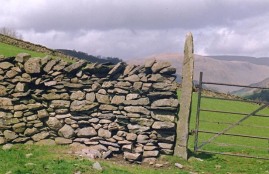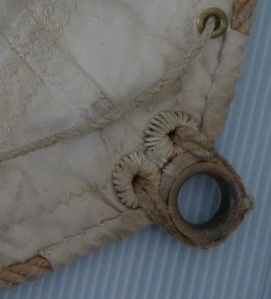Is a wall and a wall,
Leaning together
(Cumberland and Westmorland
Champion wrestlers)”
so says Norman Nicholson.
What a wonderful image! For the walls here are often made up of two separate walls enclosing a centre filled with small stones called “heartings”. The construction has long “through” stones to tie the two outer walls together and is finished off with a final top course of thinner slab-like stones on top of which the “cams” or coping stones were placed.
And Cumberland Wrestling is a traditional sport you can often still see at the Summer Shows including our own Broughton & Millom Show.  The origin of this style of wrestling is a matter of debate, with some describing it as having evolved from Norse wrestling; others associate it with a Celtic tradition. It’s great fun to watch and as they start, gripping each other around the backs, it is easy to see why it reminded Nicholson of the Lake District walls which are some of the most distinctive and most loved features of the fells.
The origin of this style of wrestling is a matter of debate, with some describing it as having evolved from Norse wrestling; others associate it with a Celtic tradition. It’s great fun to watch and as they start, gripping each other around the backs, it is easy to see why it reminded Nicholson of the Lake District walls which are some of the most distinctive and most loved features of the fells.
“The wall walks the fell –
Grey millipede on slow
Stone hooves;”
Quotations taken from Norman Nicholson’s “Wall” in his 1981 collection “Sea to the West”. © The Trustees of the Estate of Norman Nicholson, by permission of David Higham Associates Limited.



 There’s a SMOOT which, I think, is any small hole generally ground level in the wall. I have come across two types: a Water Smoot for drainage and a Rabbit Smoot. I was curious as to why a farmer would take the trouble to build a rabbit tunnel until I came across this on the Ruskin Museum’s website :
There’s a SMOOT which, I think, is any small hole generally ground level in the wall. I have come across two types: a Water Smoot for drainage and a Rabbit Smoot. I was curious as to why a farmer would take the trouble to build a rabbit tunnel until I came across this on the Ruskin Museum’s website : Occasionally in walls beside farms, we have also come across a small recess with a slate base. This is a BEE BOLE. The farmer would put his straw bee hive or skep on this to protect it from rain and wind. A Bee Bole usually faced South to South East so that the morning sun would warm up the hive. You can see a Bole at Beatrix Potter’s Hill Top though it is filled with a more modern hive.
Occasionally in walls beside farms, we have also come across a small recess with a slate base. This is a BEE BOLE. The farmer would put his straw bee hive or skep on this to protect it from rain and wind. A Bee Bole usually faced South to South East so that the morning sun would warm up the hive. You can see a Bole at Beatrix Potter’s Hill Top though it is filled with a more modern hive.  And a SQUEEZE STILE is just as you would imagine … instead of steps built into the wall, you must squeeze through the small gap. Unfortunately, overweight dogs of the Team Rigg party need to be lifted over the obstacle.
And a SQUEEZE STILE is just as you would imagine … instead of steps built into the wall, you must squeeze through the small gap. Unfortunately, overweight dogs of the Team Rigg party need to be lifted over the obstacle. How marvellous! Here at Sykehouse Cottage we just love the cabinet of curiosities that is Kendal Museum. The place houses the Kendal and Westmorland Galleries, the World Wildlife Exhibition, The Lake District Natural History Gallery and The Hamer Mineral Collection.
How marvellous! Here at Sykehouse Cottage we just love the cabinet of curiosities that is Kendal Museum. The place houses the Kendal and Westmorland Galleries, the World Wildlife Exhibition, The Lake District Natural History Gallery and The Hamer Mineral Collection.







